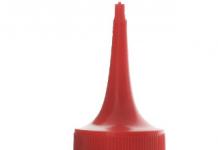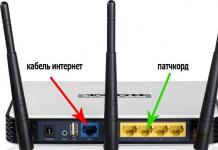The question of how to turn on sound on a laptop is extremely common among novice users. The problem can arise for many reasons - both due to the inattention of the user himself, and as a result of any software failures. We will try to create step-by-step instructions, following which each of you will be able to turn on the sound on your PC.
Often the reason for the lack of sound is extremely banal and is literally on the surface - it can be disabled in the system parameters.
To check this you need to:
- Click on the speaker icon in the lower right corner of the desktop window and check if the sound is muted.

- If everything is in order in this window, but the sound still does not work, right-click on the same icon and select “Open volume mixer”.

- Check the settings in the window that opens.

- Having checked everything in the above points, click on the speaker icon again, but this time select the “Open sound settings” item. In the system settings menu that opens, we check whether the laptop speakers are actually selected as playback ones, and also adjust the volume settings.

- If everything is set correctly, but the sound does not start working, we try to use the system error correction tool. To do this, click on the “Troubleshoot” button.

- No further action is required from the user - we wait for the test results and follow the instructions of the program that will provide assistance.

- You can check the functionality after completing all operations by going below and clicking on the “Sound Control Panel” button.

- Right-click on the speakers and click on the “Test” button.

If after these steps there is no sound, then the operations performed did not correct the problem. What to do? It’s simple – move on to the next steps of the instructions.
Let us clarify that the reason for the disappearance of sound can also be a keyboard containing hot keys for controlling the speakers. Usually the Fn key + one of the F1 - F12 buttons is responsible for this - manufacturers depict the corresponding icons on them.
BIOS Settings
Loss of sound may also be associated with the following problem - the sound card is disabled in the BIOS settings. Changing these settings is not the easiest method of solving problems, so you need to treat it with special care, and it is recommended to check the functionality of the changes when you first start it through safe mode.
To turn on the sound card in this case, you will have to do the following sequence of actions:
- We reboot the laptop, and when it starts to turn on, press the hotkey for calling up the BIOS. The specific key you need to press depends on the laptop model. Acer, HP, Asus or Lenovo - each company assigns its own button. So just search for this information online or look at the bottom of the startup window when you log in. For example, on Asus laptops the F2 key is responsible for this function.

- In the open BIOS, go to the “Advanced” section and use the keyboard to select the item containing the word “Audio”. The found item should be set to “Enabled”. If this is not the case, then change the value to the desired one using the keys F5 and F6 or Pg Up and Pg Dn.

- Having received the desired result, press the F10 button and save the changes made. Reboot the computer.
Disabling the card in the BIOS could have been caused by either the actions of an unknowing user or the activity of a virus.
Driver problems
A sound card, like any other device, requires the latest versions of drivers in the system to operate; if they are missing, problems may arise.
To check the availability of drivers and update them to the latest version, we carry out the following sequence of actions:
- Right-click on the “Start” menu and select “Device Manager.”

- Find the “Sound, game and video devices” section, click on the audio device and select the “Update drivers” line. If there are no audio devices in this section, and among other devices there are unknown ones with a “?” sign, then the drivers are not installed at all.

- We perform an automatic search for drivers. If new versions exist, the system will automatically find and install them.

- If the device is displayed as unknown, you should install the drivers from the CD that came with the laptop or from the official website of its manufacturer.
In most cases, the above steps will solve all problems. However, there is one more detail that can turn off the sound.
Audio service disabled
A non-starting audio service can be a major cause of muted audio. To run it, follow the instructions below:
- Right-click on “Start” and open the “Computer Management” section.

- Expand the “Services and Applications” tab, double-click on the “Services” button, find the “Windows Audio” line in the drop-down list, click on it and click on “Run”.

- We restart the computer and check for sound (music or Skype) - all problems should be resolved.
If there are system problems in Windows, one of the proposed methods should fix the problem.
Device malfunction
If none of the above methods for solving the problem helped, then we can conclude that the reason is not at all due to system errors. Perhaps the speakers or the sound card itself have failed.
To check this, just connect some external playback device to your laptop - for example, a speaker or earphone. We try to play something - if there is sound from the connected external device, then the problem is in the speakers. If not, the sound card is faulty. In any case, the laptop needs servicing.
Results
We examined in detail all the possible reasons why the sound on the computer disappeared, and also examined ways to solve them (suitable for both Windows 7 and Windows 10 and 8).
When checking, it is recommended to first review the system settings - perhaps the user (through ignorance or inattention) himself turned off the sound or sound card. It will take literally a few minutes to fix this problem.
If no software errors were found, you should check the serviceability of the playback device - if the problem is in the speakers or sound card, then the sound can only be restored by carrying out a high-quality repair.
Video instruction
Instructions
First of all, check if the system sounds are playing. Open the Sounds and Audio Devices Properties window by selecting Sound, Speech, and Audio Devices in Control Panel, and then selecting Sounds and Audio Devices. Go to the “Sound” tab, select any program event and sound file from the drop-down list, click the play button.
If system sounds are not playing, open the “Volume” window by pointing to the “All Programs”, “Accessories”, “Entertainment” commands in the “Start” menu and selecting “Volume”. Make sure the "Off" checkbox is unchecked. All". Here, check to see if the “Off” checkbox is checked. for corresponding devices other than the microphone input.

If the computer plays system sounds, but does not play sounds from various devices, such as CDs, check that these devices are working correctly, that they are connected correctly, and also make sure that these devices have been installed.
Finally, the reason for the absence may be problems in the sound card drivers. If after these procedures the sound does not appear, try these drivers. First of all, remove all audio – . Open the “Device Manager” window, select “Sound, video and game devices”, then select the name of the installed driver, usually Realtec AC97 or C-media, if there are no such drivers, then “Multimedia audio controller”, right-click and select "Properties". In the “Driver” tab, click the “Uninstall” button, then click the “Update” button. Insert the driver CD from yours and follow the instructions.

note
This procedure does not guarantee that the system will be completely restored to its previous state; However, you should be able to recover your data using this procedure. Warning Do not use the procedure described in this article if your computer has an operating system installed by the hardware manufacturer.
Helpful advice
How to restore the system? 1. Click on the “Start” button at the bottom right of the screen and select “Control Panel”. The main window of the Control Panel of the Windows 7 operating system will open: 2. Click on the very first section “System and Security” and in the window that opens, select the subsection “Restore the computer to a previous state”.
Sometimes Windows XP users have problems setting up sound input and output devices in the system, in particular, setting speaker volume.

Instructions
The sound control window will open with controls for various sound parameters. By moving the pointer down or up, you decrease or increase the sound volume. By checking the “Off” box, you turn off the sound altogether.
Adjusting the pointer labeled "Balance" will help you adjust the ratio of sound in the right and left. You can adjust the volume of parameters such as “Wave” - the volume of digitized formats; MIDI volume, CD playback volume, line-in volume, PC volume and other parameters.
To fully display all the options available in the sound settings, open the menu and select “Properties and Options.”
Select a recording setting or a playback setting, depending on whether you're adjusting audio input or output, and then check the boxes for any options you want to appear in the adjustments.
Open the "Volume" tab and check the box next to the phrase "Show icon on the taskbar." Also in this tab you can manually edit some sound parameters.
Sources:
- adjusting speaker volume
On any computer, a sound card with installed software is responsible for sound reproduction. To turn on sound on your computer, you need to perform a number of specific steps.

You will need
- Computer.
Instructions
Video on the topic
Long gone are the days when a computer was considered a luxury and was used mainly only for work. With the advent of cheap components, almost everyone can buy a PC. There are so many users, so many requests - some need a workstation, while others need an entertainment center. However, regardless of how the computer is used, availability is almost always a must. Let's look at examples of solving this problem.

You will need
- - instructions for using the sound card
- - any sound output device. For example, speakers or headphones (for sound testing).
- - microphone (optional). Also to check the operation of the audio card.
Instructions
First of all, you need to decide what role your PC will play for you. True music lovers and multi-channel audio enthusiasts will undoubtedly need an external sound card, which can cost a pretty penny depending on the model.

For other users and most gamers, the sound card built into the motherboard will be enough.
To determine whether you have built-in audio, carefully examine the back wall of your system unit. An example of audio outputs is shown in the figure.
In the sound control panel, you can not only adjust volume levels, but also apply various effects to the sound, and also enable the noise reduction function (the type of panel itself and the capabilities provided depend on the brand of sound card).
If the audio card is external, then after installation you will most likely also be able to see the shortcut in the general list of installed programs. (for example, “Start” - “All Programs” - “Name of sound card brand”).
Of course, it is impossible to check the operation of a sound card without speakers or headphones. Connect them to the corresponding connectors on the sound card. Observe the color coding - the speaker/headphone plug (usually green) must be installed in the green connector of the sound card. Microphone - pink. The remaining connectors are used to connect multi-channel systems.
To accurately determine the purpose of certain colors of sound card outputs, use the instructions for the sound card (a separate document in the case of an external sound card and a section in the instructions for the motherboard).
Also, the purpose of the sound card outputs in most cases can be found in the sound control manager.
Video on the topic
Sources:
- Setting up sound on your computer
It's not difficult to install. As a rule, it should be automatic, since modern operating systems contain many drivers and a hardware detector. Otherwise, you need to use other drivers or configure the BIOS.

Instructions
Installation under favorable conditions is very simple. As a rule, Windows should appear automatically after installation, since modern versions of this operating system (starting with Windows XP) are supplied with driver kits. If it does not appear automatically, then in the system tray (the notification area is usually located at the bottom right, not far from the clock) the inscription “new equipment” should appear, where the new card should be included. During installation, you will be asked for the driver category for the new card. It is best to use a system or special disk containing drivers for this, or try specifying the directory C:WINDOWSsystem32drivers
If it is not installed as standard and no automatic notification appears, then you need to do it manually. You need to right-click on “my computer”, then select “properties”, in the properties click on the “hardware” tab, select device manager there. In the manager itself, you can try clicking on “new devices”, then selecting the “update hardware configuration” item at the top. Then point either to the director with Windows drivers, or (if available) to use a special disk with drivers.
You can also use the Everest utility to search for drivers; it accurately identifies devices and helps in finding the necessary drivers. If there are no technical obstacles, then this method should help.
Sometimes the new card is disabled in the BIOS. Such a conflict often arises due to the fact that there is a built-in (on the motherboard) and a separate new card. In this case, preferably from a new card. To do this, you need to go into the BIOS like this: press the “del” key several times until you reach the menu. In the menu, select the “Advanced BIOS Features” item, and then look for the “Onboard Audio” item. When you find it, you need to click and select the “Disabled” position. After which you must exit to the menu (using the Esc key) and click “Save and Exit Setup”
Video on the topic
In most cases, when computer disappears and no actions lead to its restoration, the cause of the problem lies in a malfunction of the new card driver. It should be noted that simply replacing drivers will not be enough to fix the problem.

Instructions
Insert the media containing the drivers for your new card into the drive. Wait for the disc, then install the required software, following the instructions during installation. After the driver installation is completed, reboot the system through the Start menu (on the taskbar, many users confuse it with the button).
Once your computer is ready to use again, connect devices a. You should not connect them all at once (if you are using headphones at the same time), connect them one at a time. So, after connecting the headphones, set the option menu to “Headphones” and click “OK”. Next, connect another type of device and set the corresponding parameter. If the dialog box does not appear, it means that the system has automatically configured the required device type.
In both Linux and Windows, if the version of the operating system is modern, there is a very high probability that the sound card, either built-in or separate, will be detected automatically and no manual settings will be required. If this does not happen, configure the sound card manually.
To configure your sound card manually on Linux, run the alsaconf program. Answer positively to all questions that appear on the screen. The script itself will determine which sound card you have, and, if it is supported, will configure it. If the sound does not appear after this, check the status of the mixer - sometimes in Linux the volume is set to zero by default.
In Windows, if the sound card is not recognized automatically, install the drivers from the disk that came with it. If there is no disk, find out the type of card by the markings on it, and then download the appropriate drivers from the Internet. Sometimes there are no markings on the board - then seek help from a person who is familiar with various brands of computer peripherals. You can also take a photo of the card and post it on the forum for identification.
To connect headphones or speakers to the board, use the green socket. Remember that modern sound cards, unlike those produced in the nineties, are not equipped with powerful amplifiers. To ensure loud sound, use only active speakers with the board.
Video on the topic
Installation and update drivers is a very important process that must be performed after loading a new operating system. There are several ways to select a suitable set of files.

You will need
- - Internet access.
Instructions
First try installing the native driver for your card. Use the disk that came with your computer. If the system unit has a sound card integrated into the motherboard, then the drivers for it may be located on the disk from the motherboard.
If you do not have such disks, then connect to the Internet and visit the website of the manufacturer of this model of sound adapter or motherboard. Download from there a set of files suitable for your devices. Open the My Computer menu properties and go to Device Manager.
Now find the name of the sound adapter and right-click on it. Select "Update Drivers". In the menu that opens, click on “Install from a specified location.” Now specify the folder where you saved the downloaded files. It is recommended to first extract data from the archive.
Unfortunately, it is not always possible to correctly select the necessary drivers yourself. Download the Sam Drivers utility, which is designed to automatically select and install suitable drivers for most devices. Launch this program and select the Driver Install Assistance option.
Now wait a while so that the utility can scan the connected devices and find suitable sets of files for them. After completing this procedure, check the boxes next to Audio New and Audio Other. Now click the “Install selected packages (2)” button. In the menu that opens, select the “Silent installation” option.
Wait for the file update process to complete. Restart your computer. Check the functionality of the sound card. Open the installed program, the icon of which should appear in the system tray. Configure the sound adapter settings.
Video on the topic
It's hard to imagine a computer that doesn't have sound. You can't listen to music, you can't watch a movie, and playing games is boring. To change the current state of things, you will need a sound card and at least some speakers. Read on to find out how to connect and install them.

Instructions
Determine whether a sound card is installed in the system unit of your personal computer. To do this, carefully inspect the rear panel of the system unit. If you have a sound card, you will find a board with at least three different colored inputs. This sound card is suitable for people who do not have any special requirements for sound - “it’s good.” If you want to put good sound on your computer, then you will need a good external sound card and, of course, a good speaker system, which, by the way, are not cheap at all.
Install drivers for the built-in sound card. Typically, these drivers are installed automatically when you install drivers on your motherboard. If for some reason this does not happen, then open the list of devices on your personal computer. To do this, right-click on the “My Computer” icon on the desktop. Then select the Hardware tab.
Find your sound card in the list of devices. To install sound, click on the “Drivers” button, then click “Update”. First, insert the motherboard driver disk into the drive. During the update process, indicate it as the source. If the disk was lost, download all the necessary drivers from the official website of the motherboard manufacturer. After the drivers are installed, restart your computer.
Make additional sound settings. The settings that are installed automatically may not suit you in many ways. Perhaps you want to apply some audio processing or something like that.
To set the sound on your computer to your taste, right-click on the speaker icon, which is located in the lower right corner of the taskbar. A small menu will appear in front of you. Select the “Adjust audio settings” item. Adjust the speaker volume. If your sound card driver allows, use some kind of equalizer. Save your settings.
Video on the topic
Comfortable work is only possible on a fully functional computer. Sometimes the user is surprised to notice that the computer has lost sound; such a malfunction makes it impossible to listen to music and fully view video files.

In the vast majority of cases, the disappearance of sound is associated with the installation of a program, system update, or installation of a new OS version. If there is sound, open: Start menu, Control Panel, System, Hardware, Device Manager.
In the window that opens, expand the “Sound and gaming devices” item. You will see one or more devices highlighted in yellow. This means that this device is not working correctly.
There is usually only one reason for incorrect operation - the lack of the required driver. Double-click the selected device, you will see a message stating that no drivers have been installed for this device. They are usually located on the disk that comes with the motherboard, but may also be present on the installation disk with the operating system.
Insert the driver disk into the drive, start reinstalling the driver by clicking the “Reinstall” button. In the window that appears, select automatic installation. The disk will begin searching for drivers; this process may take some time. If the installation is successful, you will see a corresponding message.
If there are several devices highlighted in yellow, search for drivers for each of them. Then restart your computer and the sound should appear. If Windows does not find the necessary drivers on the disk, try looking on another one, even if it is a disk from a different build of the operating system.
If you couldn’t find the necessary drivers on the disks you have, look for them on the Internet. Go to the official website of the sound card manufacturer, or, if you have . Unpack the found drivers (if they are packaged) into one of the folders on your hard drive, and then, during the installation process, select the “Install from a specified location” option and specify the folder with the drivers.
If after checking your computer you see that all devices are working fine, but there is no sound, check your sound settings. Open the "Control Panel", select the "Sounds and Audio Devices - Audio" section. The sound may be muted or the sound adjustment sliders may be set to the lowest position. Finally, check your speakers to see if they are the reason for the lack of sound. To check, connect headphones to the computer - if there is sound, it means the computer is working and the cause of the problem should be looked for in the speakers.
Sources:
- No sound on the computer, what should I do?
The possibilities of a computer are almost limitless. One of these opportunities is to download or record your favorite music. Listening to a recording may be disturbed by the lack of sound. There may be several reasons why the sound suddenly disappeared.

The reasons for the lack of sound are divided into hardware and software. Hardware reasons include various breakdowns of computer audio devices (headphones, speakers). Software problems include errors in the computer software.
A hardware problem is easy to detect. It is enough to switch the speakers to another source (phone, mp3 player). No sound will mean that the speakers or headphones are faulty. If there is sound, you should check the connection. It is possible that the headphones or speakers were simply connected to the wrong connector (on the back of the computer it is usually green). Also, the reason for the lack of sound may be faulty wiring.
Software problems require closer inspection. First, you should test the service on your computer that is responsible for sound. There should not be an icon in the form of a speaker with a prohibitory sign in the lower right corner of the screen. By clicking on the icon, you can connect by setting all parameters to maximum. After checking, you can enjoy the reproduced sound.
You can check if your computer's sound system is working correctly through the control panel. In the “Sounds” tab, make sure that the audio devices are selected and connected correctly. If this task is missing, you should make the connection again.
There may be no sound on the computer after reinstalling the Windows operating system. Installing special drivers that are responsible for reproduced . Such drivers help your computer communicate with your video card, gaming devices, or sound card. Drivers can be downloaded freely on the Internet.
The reason for the lack of sound may be a malfunction or damage to the sound card. To check, you will need another sound card. If the sound works with it, then the problem is in the original card and it needs to be replaced.
Viruses often remove or corrupt sound drivers, making sound playback impossible. You should scan your computer for viruses using standard antivirus programs (Kaspersky, etc.).
As you use your computer for multimedia content, the audio settings change from the default values. This does not always have a good effect on the adapter's performance.

You will need
- Internet connection.
Instructions
Remove the drivers for your sound card from the list of programs installed on the system in the control panel of your computer. Restart your computer, and then, just in case, clean the operating system registry, using utilities specifically designed for this that can be found on the Internet.
You can also clear the registry entries manually if you have the skills to work with it, but it is recommended that you create a copy of the working system configuration before doing this.
Download the latest stable version of drivers for your sound card from the official website of the device manufacturer, then install them on your computer using the Add Hardware Wizard, or simply by running the downloaded software installer. Restart your computer, then settings will return to its original state.
If you don't want to bother reinstalling sound adapter drivers, return settings by default using a rollback of the operating system state. This action should only be performed if no significant changes have been made since the installation of the sound card driver until the current date, since all of them will be cancelled.
Open the Start menu and go to the list of standard utilities. Choose to restore the operating system, read the main points of performing this operation.
Save your user files and settings configurations of programs that you will have to reinstall or configure in the future, run a system restore, specifying the date as close as possible to the time the change was made to settings sound adapter. Wait until your computer restarts and check if it works.
Helpful advice
Save system settings frequently before making changes.
Today you can see the emergence of many programs for messaging, as well as for creating video conferencing. Among other applications, there are always several leaders, for example, Skype, for which you may need to configure to work.

The main components of a computer's sound system are a sound card and an audio output device - speakers (speakers) or headphones. Sound cards of modern computers are sold in two main categories:
- integrated into the computer motherboard (on board);
- separate (discrete) sound cards installed inside the computer system unit.
There are also cheap or very expensive (for professional musicians) external sound cards with a USB connector.
The widespread first option involves wiring the sound chip onto the motherboard. The more expensive the latter, the better the chip used in it. But even in this case, the sound quality in on board cards cannot be called high, although it is quite satisfactory for ordinary users. The influence of interference from nearby other elements of the system unit sometimes leads to the audio signal in such cards being distorted. In addition, if the processor is heavily loaded, the sound stutters.
Discrete sound cards have significantly higher audio performance. The audio signal is processed in them by a specialized sound processor. The delivery package of such a board includes special software that implements various acoustic effects. It should be noted, however, that the potentially high sound quality can be offset by ordinary speakers or headphones. It is recommended, in particular, to use speakers with wooden bodies.
Reasons for sound loss
Sometimes, after turning on or during operation, the computer may lose sound. Why is there no sound on my computer? The reason for the disappearance or distortion may be problems in its software or hardware components:
- poor contact or failure of speakers or headphones;
- incorrect audio device settings;
- driver damage;
- malfunction of the sound or motherboard (for on board version) board;
- incompatibility with other programs or drivers;
- incorrect BIOS settings;
- exposure to viruses.
The easiest ways to recover
If the sound just disappeared, you should restart your computer. It happens that problems with sound are the result of an accidental failure. If the problem persists, make sure that the speaker switch is turned on and not pushed to its extreme position. Then visually check that the speaker (or headphone) plug is securely connected to the corresponding (green) socket on the computer. Poor contact with the jack can also cause the sound to wheeze. The functionality of the speakers themselves can be checked by connecting to another sound source - a player, smartphone, or another computer.
In the entire line of operating system versions in use - Windows 7/8/10, as well as in the outdated Windows XP, there is a universal tool - “System Restore”. It allows you to return your computer to a working state. If the sound was normal, for example, a day or a week ago, then you can “roll back the clock” and return to this state. The screenshot below depicting sequentially opened windows explains the return algorithm (“Control Panel” -> “System” -> “System Protection” -> “Recovery” -> selecting a restore point -> “Next”). After the computer automatically restarts, the sound should be restored. 
Configuring Audio Settings
Inexperienced computer users could unknowingly turn off the sound from the taskbar (crossed out speaker or down slider). If this is the case, then you need to restore it, as shown in the screenshot (to delete the shutdown, click on the speaker icon).

Then you should go to “Start” -> “Control Panel” -> “Administrative Tools” -> “Services” and make sure that the Windows Audio service is automatically started and running; otherwise, restart it.

To check the audio settings, go to “Start” -> “Control Panel” -> “Sound” and make sure there is a green checkmark next to the sound device you are using. This means the speakers are working. Otherwise, click on the “Properties” button,

then open the lower list in a new window, select the “Use this device” option and click OK.

Reinstalling drivers
You can verify that the sound card is working in the device manager: “Start” -> “Control Panel” -> “Device Manager”. After opening the “Sound, video and gaming devices” list, the presence of a model (Realtek High Definition Audio) and the absence of an alarming yellow exclamation mark next to the line means that everything is in order. If you right-click on this line, then click “Properties”, a notification “The device is working normally” will appear in a new window.

Otherwise, you need to update or reinstall the driver. The same need sometimes arises after installing a new, partially incompatible device or program. To update, right-click on the Realtek High Definition Audio line and click “Update drivers” in the drop-down list.

A new window offers two ways to find updated drivers with explanations.

In some cases, the effect is achieved only after removing the existing driver (see previous screenshot) and installing it again from scratch. The Windows 7 operating system should automatically install the missing driver upon reboot (Plug and Play). If this does not happen, then the required driver can be taken from the disk included with the discrete sound card or motherboard upon purchase. Finally, as a last resort, the driver can be found and downloaded on the Internet on the website of the card or board manufacturer.
Sound or motherboard problems
These faults are complex and are detected using special equipment in service workshops. However, if you have the same computer in your office or home (for example, a neighbor’s), you can replace the suspected board with a known good one. After checking in this way, the problem can be solved by purchasing a new board.
BIOS Settings
It is possible that an inexperienced user, unwittingly, turned off the integrated sound card in the BIOS settings. To enable it, you need to restart the computer, enter the settings (by pressing the Del key before the system boots), find the Onboard Devices Configuration section and replace Disabled with Enabled. At the same time, keep in mind that if you are using a discrete sound card, this option must be disabled.

No sound may be due to insufficient antivirus protection. In such cases, you need to carefully scan the entire computer, possibly using other antiviruses. Once viruses are detected and removed, the drivers will most likely need to be reinstalled as described above.
Conclusion
Consistent application of the above recommendations will restore normal sound on your computer. Similar advice can be found in other articles for the search query “Why the computer sound disappeared.”
The most common reason for no sound is turning it off or setting the volume to minimum. If there is no audio playing on your computer, hover over the speaker icon in the tray (right corner of the taskbar). The tooltip will indicate the current volume value. If the sound does not play in a separate application, check its settings. If it is enabled in the settings, audio playback in a specific program may be limited in the mixer. To check, right-click on the speaker icon and select “Open Volume Mixer.” There you can turn on the sound and adjust the volume level for each program running on the computer.
Check the volume on the playback devices themselves: headphones or speakers. When using speakers, also make sure they are connected to power and the power button is in the active position. Checking speakers or headphones is quite easy. To do this, just connect any other device to the audio output instead of a computer: a smartphone, a player.
Important! Also check your speaker settings. To do this, go to “Playback devices”, and in the context menu of speakers or headphones, click “Properties”.
Incorrect operation of audio drivers
Another common reason why there may be no sound on a computer is missing or damaged audio drivers. To identify this issue, hover over the audio icon in the tray. If the message “No audio output device is installed” appears, the problem is caused by the audio drivers.

To resolve these difficulties, right-click on the same icon and select “Detect sound problems” from the context menu.

This will open a troubleshooting window. Wait while the audio diagnostics run on your computer. Depending on the speed of the device, the process can take from a few seconds to a couple of minutes. If the determination of the cause of the malfunction stops at one place, click “Cancel”.

When the sound diagnostics are completed, the system will offer you a choice on which device you want to troubleshoot. In this case, you need to note the device used based not on its type, but on the location of the audio input. For example, if your speakers are connected through the audio input on the front of your computer, check the second box even though it says headphones.

If there is a hardware fault, the diagnostic result will be the following window. It may indicate damage to the speakers or headphones, but most often the cause of difficulties in the operation of audio devices is broken or damaged connecting cables.

At the last step of sound diagnostics, the result of its execution will be displayed. If the problems are resolved, close the troubleshooter. If the diagnostics did not help, click “View additional options.” You can also find help information about the causes of malfunctions by clicking on the “View additional information” link.

Incorrect connection or installation of the device
Sound may not work due to improper connection or installation of audio devices. To resolve this issue, check that the correct input is selected to connect your device to your computer. Speakers or headphones may be connected to the microphone input, causing them to not work.
Go to “Control Panel -> Device Manager” and check the status in the “Sound, Game and Video Devices” menu. If a yellow mark with an exclamation mark is displayed next to the name, the cause of the problem is incorrect installation or malfunction of the device

Note! If your audio hardware is not showing up in the manager at all, update the configuration in the Actions menu.
Right-click on your audio hardware and select Properties, then go to the Driver tab in the window that opens. To update the configuration, click the "Update" button. Here you can remove the driver to reinstall it later.

In the next step, select where you want to search for sound drivers. Two options are offered: automatic search, which includes a search on your computer and the Internet, as well as a simple search for drivers. It is recommended to select the first option to detect drivers.

Important! If the sound card is outdated and its driver is on a separate disk, first copy it to your computer.
The scanning will take about 20-30 seconds, after which a message will be displayed in the search window indicating the successful installation of new audio drivers. If the device already has the latest available driver installed, the configuration will not be updated.

If updating the drivers did not bring the desired result and the device still does not work, it is recommended to remove it from the system. To do this, right-click on the name and select “Delete”. Confirm the deletion in the dialog box by clicking "OK".

After this, you need to update the list of equipment in the “Action” menu. A search will be performed for devices connected to the computer. If the desired device does not appear after searching, restart the manager.

When the speakers are found, their installation will begin automatically. This process may take several minutes. When finished, a message will be displayed indicating that the speakers have been successfully connected and are ready to use.

Damage to connecting cables
Standard 3.5 mm connectors can fail as a result of mechanical damage. Typically, failure occurs at the base of the connector - at the junction with the audio cable. The break may also be in the cord itself. The cause of damage is most often pinched by furniture (table legs, chair wheels). The cable can also be chewed by pets. You can diagnose a breakdown visually or by connecting another cable to the speakers.

Physical breakdown of audio equipment
There may be no sound on your computer if the speakers or headphones you are using fail. This is not difficult to determine - just connect another audio device to the same audio input. If it works, the reason is the broken speakers, and not the computer settings.

Windows Audio Service Disabled
Another common reason for no sound is that the Windows Audio service is disabled. This background process is responsible for processing audio data and is always running by default on a running computer. But if you make changes to the system settings, the Windows Audio settings may be incorrect. The service can also be disabled by malware.
To the computer by connecting them to the appropriate jack (most often indicated by a small megaphone or speaker symbol) on the computer, laptop or monitor.
In G (click on the Start button) select Control Panel>Hardware and Sound. In chapter Sound click on the link Audio device management. In the dialog box Sound select item Speakers and click on the button Properties.
In the dialog box Properties: Speakers select tab Levels and use the Speakers slider to adjust the volume level. If the slider button displays a small red x, click it to activate the columns.

Click the button Balance. In the dialog box that appears on the screen Balance Use the L (L) and P (R) sliders to adjust the sound for the two speakers.

Triple click the button OK to close all previously opened dialog boxes and save the new settings.
If you use a computer to make phone calls, review the settings in the Connection in the dialog box Sound. The settings you select on this tab will automatically reduce background noise when you use your computer as a phone.

Adjusting the volume level of system sounds
You can adjust the volume level of system sounds. Start with what's in Main menu(Start button) select >Equipment and sound.

The following settings are available in this window:
- Slider Device Allows you to adjust the volume level of speakers connected to your computer.
- Slider Windows Allows you to adjust the volume of Windows sounds, also called system sounds.
- To mute your speakers or Windows sounds, click the speaker icon displayed below any slider and a red circle will appear in the click area.
Double click the button Close to close all previously open windows.
To quickly adjust the volume level, click on the volume button, which looks like a speaker, which is located in the notification area on the taskbar.
To adjust the sound volume, use the slider that appears in the pop-up panel. To temporarily mute the sound, click the button Mute “Speakers” sound
Share.




























